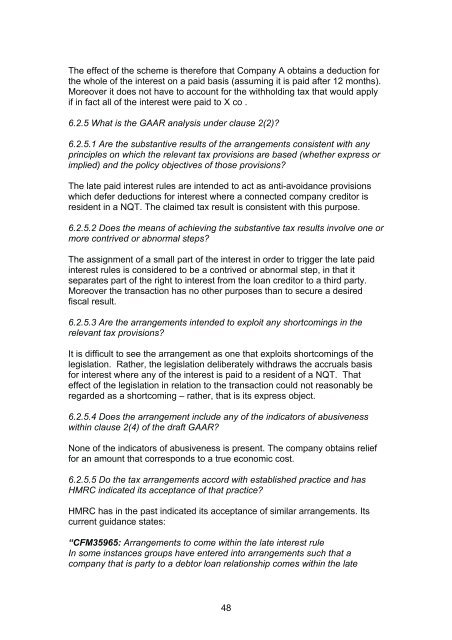Examples of how the GAAR applies to tax arrangements
Examples of how the GAAR applies to tax arrangements
Examples of how the GAAR applies to tax arrangements
You also want an ePaper? Increase the reach of your titles
YUMPU automatically turns print PDFs into web optimized ePapers that Google loves.
The effect <strong>of</strong> <strong>the</strong> scheme is <strong>the</strong>refore that Company A obtains a deduction for<br />
<strong>the</strong> whole <strong>of</strong> <strong>the</strong> interest on a paid basis (assuming it is paid after 12 months).<br />
Moreover it does not have <strong>to</strong> account for <strong>the</strong> withholding <strong>tax</strong> that would apply<br />
if in fact all <strong>of</strong> <strong>the</strong> interest were paid <strong>to</strong> X co .<br />
6.2.5 What is <strong>the</strong> <strong>GAAR</strong> analysis under clause 2(2)?<br />
6.2.5.1 Are <strong>the</strong> substantive results <strong>of</strong> <strong>the</strong> <strong>arrangements</strong> consistent with any<br />
principles on which <strong>the</strong> relevant <strong>tax</strong> provisions are based (whe<strong>the</strong>r express or<br />
implied) and <strong>the</strong> policy objectives <strong>of</strong> those provisions?<br />
The late paid interest rules are intended <strong>to</strong> act as anti-avoidance provisions<br />
which defer deductions for interest where a connected company credi<strong>to</strong>r is<br />
resident in a NQT. The claimed <strong>tax</strong> result is consistent with this purpose.<br />
6.2.5.2 Does <strong>the</strong> means <strong>of</strong> achieving <strong>the</strong> substantive <strong>tax</strong> results involve one or<br />
more contrived or abnormal steps?<br />
The assignment <strong>of</strong> a small part <strong>of</strong> <strong>the</strong> interest in order <strong>to</strong> trigger <strong>the</strong> late paid<br />
interest rules is considered <strong>to</strong> be a contrived or abnormal step, in that it<br />
separates part <strong>of</strong> <strong>the</strong> right <strong>to</strong> interest from <strong>the</strong> loan credi<strong>to</strong>r <strong>to</strong> a third party.<br />
Moreover <strong>the</strong> transaction has no o<strong>the</strong>r purposes than <strong>to</strong> secure a desired<br />
fiscal result.<br />
6.2.5.3 Are <strong>the</strong> <strong>arrangements</strong> intended <strong>to</strong> exploit any shortcomings in <strong>the</strong><br />
relevant <strong>tax</strong> provisions?<br />
It is difficult <strong>to</strong> see <strong>the</strong> arrangement as one that exploits shortcomings <strong>of</strong> <strong>the</strong><br />
legislation. Ra<strong>the</strong>r, <strong>the</strong> legislation deliberately withdraws <strong>the</strong> accruals basis<br />
for interest where any <strong>of</strong> <strong>the</strong> interest is paid <strong>to</strong> a resident <strong>of</strong> a NQT. That<br />
effect <strong>of</strong> <strong>the</strong> legislation in relation <strong>to</strong> <strong>the</strong> transaction could not reasonably be<br />
regarded as a shortcoming – ra<strong>the</strong>r, that is its express object.<br />
6.2.5.4 Does <strong>the</strong> arrangement include any <strong>of</strong> <strong>the</strong> indica<strong>to</strong>rs <strong>of</strong> abusiveness<br />
within clause 2(4) <strong>of</strong> <strong>the</strong> draft <strong>GAAR</strong>?<br />
None <strong>of</strong> <strong>the</strong> indica<strong>to</strong>rs <strong>of</strong> abusiveness is present. The company obtains relief<br />
for an amount that corresponds <strong>to</strong> a true economic cost.<br />
6.2.5.5 Do <strong>the</strong> <strong>tax</strong> <strong>arrangements</strong> accord with established practice and has<br />
HMRC indicated its acceptance <strong>of</strong> that practice?<br />
HMRC has in <strong>the</strong> past indicated its acceptance <strong>of</strong> similar <strong>arrangements</strong>. Its<br />
current guidance states:<br />
“CFM35965: Arrangements <strong>to</strong> come within <strong>the</strong> late interest rule<br />
In some instances groups have entered in<strong>to</strong> <strong>arrangements</strong> such that a<br />
company that is party <strong>to</strong> a deb<strong>to</strong>r loan relationship comes within <strong>the</strong> late<br />
48

















